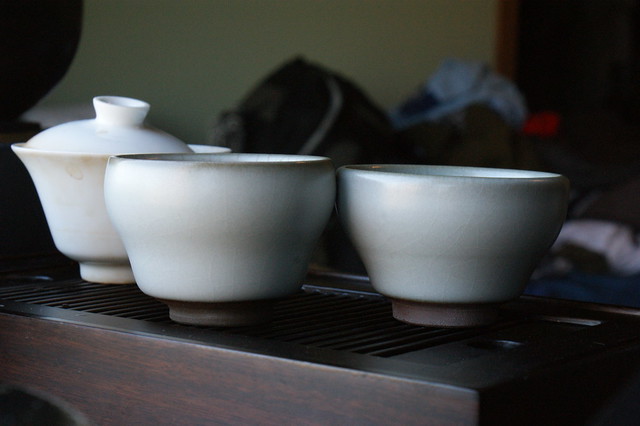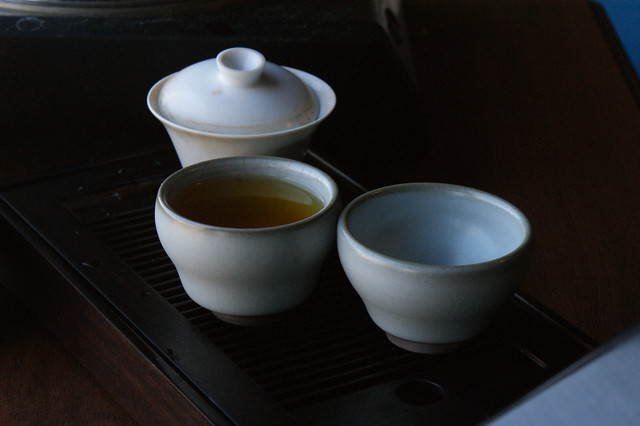A project of a year in the making, which sadly the most I participated in this offering was to be a "pre-commited" participant. This is The Eiichi Commission which at long last we have seen pictures, and given a name to the design of this project. It is somewhat ground breaking in the sense that previously the glaze colors done by Eiichi have been White, White, White, and more White, either thick or thin, perfect coatings or crawling with cracks. This project was given the name of Kohiku, which is the name for a somewhat traditional Hagi glaze style in which a bit of color change is aimed for after applying a slip glaze doing a Bisque fireing and then applying an over glaze and firing once more.
Photos can be found here, and as I am pre-committed I definitely will have one finding its way to me. Those of you familiar with the styles of Yunomi's/ teacups that I like may already have a decent guess at what style(s) my hopeful choices were from.
I will say I was quite impressed with these pieces in general, although I am not overly fond of the bright orange color. I am secretly hoping that these are telling pictures but not super accurate in terms of color, and that the color is actually a bit more neutral and passive in nature. Although I would love to see how this fire-orange ages and progresses through the 7 stages of hagi with use.
Look forward to another post (or more) in the somewhat near future.
Sunday, January 22, 2012
Tuesday, December 27, 2011
Xu De Jia Small Chawan Celedon Cups

A Chistmas gift from my parents, these 50 ml celadon cups are the 2nd (and 3rd) pieces of celadon ware I have. There are many types of celadon, ranging from super glossy almost glassy looking, to this satin type of finish. The colors can also vary wildly from an almost blue color, to pale white, I have even seen some slightly brownish grey pieces.
The funny thing about these cups, is it was not until I took the above picture and looked at it, that I realized how incredibly different these two cups were. Yes they are the same basic shape, same color, but I honestly never fully realized that one is slightly shorter but much wider, while the other is more upright and taller. Its small details like those that give me a bit of comfort that yes these are actually hand made. And the differences are only noticeable when you have them side by side. If you held one in each hand, about a foot apart from each other, and looked at the one in each hand one at a time. In that situation I think almost anyone would deem both pieces identical.

These pieces just reaffirm my new found fondness for celadon, although all 3 pieces I have are from the same artist Xu De Jia. And I am quite fond how (at least in this slightly aqua marine colored glaze) at the very rim of the cup there is a noticeable difference in the glaze.
Tuesday, November 29, 2011
Shibuya Eiichi Wood fired Yunomi

I believe this is my first wood fired piece, from a young artist that is quickly making a name for himself both in the US and in Japan. This Yunomi shows his incredible talent in so many ways. While obviously wheel thrown, the way in which he did not overly smooth out the sides of the cup, and left decent curling ridges working their way up the sides of the cup, creates an almost ideal grip on this otherwise slippery piece. So much so that with my somewhat large hands, with an empty cup, I can manage to hold it (not incredibly well) with just my middle and ring fingers curled around one side, pressing it against the pads on the palm side of my knuckles.

The piece seems so ideal in how it fits into my hand, feels surprisingly light and soft for its size, that I am just absolutely thrilled. Even more so it has some characteristics I have long since wanted from a White Hagi Yaki piece, that only exist when wood fired. That is the white is actually a subtle pink in most places that darkens or lightens with the effects of what was going on around it in the kiln.

The biggest con in my eyes, is the foot is quite ugly, and ugly in the sense that it looks like he sanded off a hell of a lot of wadding to smooth out the bottom of the cup. Which when you look at the foot, it lacks the soft look and feel that the rest of the cup has so much of. The sanded and smoothed out sections look rough, and raw, and especially scarred.
Subscribe to:
Posts (Atom)
